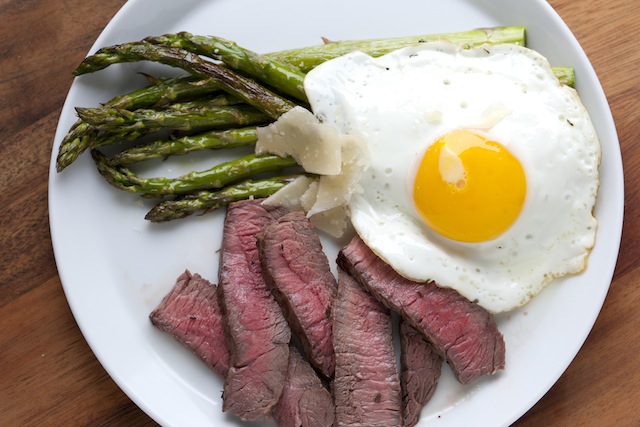The basic rule of a diet is calorie limitation. Theoretically, if you eat fewer calories than your daily energy requirement, weight loss occurs. Practically, the problem is a lot more complicated. First of all because the body is forced to turn its own resources into energy, ideally fat. The body can also use muscle, resulting in muscle loss and nobody really wants that.
The cyclical ketogenic diet is a diet for active people who regularly workout and it has a very simple goal: to jumpstart your body into burning fat more effectively without losing muscle mass. If you do weight training, the CKD can also help you gain muscle faster.
CKD Lifestyle

CKD premises
All ketogenic diets are very low in carbs and high in fat and protein. The goal is to “teach” your body to use fat as its primary energy source instead of carbohydrates.
Broken-down carbohydrates are stored in both fat and muscle cells as glycogen with the help of insulin. A low-carb or no-carb diet forces the body to find another energy source. The result is an increase of catecholamine, a hormone for fat metabolism and cortisol, another hormone with a role in metabolism. Obviously, the next go-to energy source is fat.
When the body uses fat as its main energy source, it will also produce chemical compounds known as ketones, entering the state of ketosis. But this can’t happen if you eat sugar and carbs since both nutrients are stored as glycogen. To enter the state of ketosis, the liver must be out of glycogen.
Currently, there are two commonly used methods used to enter ketosis. The first one, we’ve already talked about and that is intermittent fasting. IF diets consist of long periods of time with no eating which after the last meal is completely digested will force the body to burn fat and release ketones.
The cyclical ketogenic diet has another approach, and that is to cut carbs completely and keep the body into ketosis for longer periods.
Required calculations
The first thing you need to do is find your total lean body mass, which means everything besides fat.
For that you need to know your Total Weight (in pounds) and Body Fat Percentage. Then you can find out your Body Fat Mass. Subtract the Body Fat Mass from the Total Weight and you’ll find out your Lean Body Mass.
You’ll need 1 gram of protein per pound of lean body mass. E.g: if you have a lean body mass of 160 you’ll need 160 grams of protein every day.
One gram of protein is about 4 calories so you’ll need 160×4=640 calories from protein every day.
To find out total calories you need to eat on a daily basis take your Total Weight (in pounds) and multiply it by 15. E.g: for a Total Weight of 190 you’ll need 2850 calories/day to maintain your weight.
If you want to lose weight, you can cut 500 calories from your daily requirement, and using the example above you would need to eat 2850-500=2350 calories out of which 640 calories should be protein and 2350-640=1710 calories from fat.
Stick to the above calculations from Monday to Friday. Using the same example, this would mean 2350 calories every day (1710 from fat and 640 from protein) 5 days a week.
During weekends, you have to replenish glycogen stores, which are needed for muscle recovery. This period starts on Friday after your workout and ends on Sunday at midnight.
You will need to consume about 4.5-5.5 grams of carbohydrates for each pound of body mass. Sticking to our example, that would mean 190×4.5=855 grams of carbohydrate. At the same time, you need to eat plenty of protein and very little fat.

The workout plan
The Cyclical Ketogenic Diet is highly flexible. You can set your meal hours and choose from a variety of foods as long as you stick to the needed daily amounts of protein, fat and carbs.
It’s a diet for active people who workout at least 3-4 times a week, and even better for strength training. Here is a summarized weight-lifting workout plan that you can fill in with your favorite exercises: Train weak muscle groups on Monday and Tuesday. Wednesday is a rest day or optional cardio. Train strong muscles on Thursday. On Fridays, plan your workout to include both weak and strong muscles. No workout during the weekend.
Foods and recipes
CKD is gaining popularity, and you can already find lots of interesting ideas for recipes that follow the diet’s rules. If you don’t know where to start I recommend you visit these two links: link1 and link2.
The Cyclical Ketogenic Diet’s beauty lies in its adaptability. It promises the metabolic benefits of ketosis while offering the periodic delight of carbs. Yet, it demands diligence, understanding one’s body, and meticulous planning. The journey can be rewarding, with optimal energy levels, preserved muscle mass, and fat loss. But as with all dietary approaches, it’s essential to consult a healthcare professional before diving in. In the vast sea of diets, CKD emerges as a regimen and a lifestyle, oscillating between fat and carbs.
